| Take this guide to go. Click here to download the guide for later. |
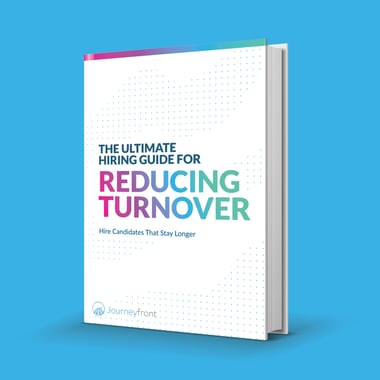
The Ultimate Hiring Guide for Reducing Turnover
Tackle your turnover in 2024 with this ultimate hiring guide. Discover how the world’s most innovative companies are reducing turnover by screening candidates for turnover risk.
80% of employee turnover is caused by bad hiring decisions- Harvard Business Review - |
In an ever more competitive economy, hiring the right person for the right job has never been more critical. With more millennials entering the workforce each year, companies are finding that turnover costs hinder their ability to scale and thrive.
Various strategies have been employed to reduce turnover in almost every industry. Most have yielded only modest results despite significant investment.
This leads to the obvious question: given how expensive turnover can be, what is the best way to reduce it? Research suggests that the most effective (and by far least talked about) way to reduce turnover is to improve the effectiveness of your hiring process.
According to the Harvard Business Review, 80% of turnover can be attributed to bad hiring decisions. This implies that post-hire programs and initiatives (where the vast majority of turnover reduction efforts take place) focus primarily on the remaining 20%.
Tackling turnover by modifying your candidate screening process represents an enormous opportunity for companies of all shapes and sizes. Companies that take this seriously will reap the rewards of appreciable improvement to their employee retention over time.
Below, we offer a step-by-step guide for how to do this. We hope that you will benefit from the research-backed ideas and suggestions that follow.
Table of Contents
-
Employee Engagement: Not the Answer to Turnover We Hoped For
-
How Much of Your Screening Process Should Focus on Turnover?
-
11 Traits You Should Screen For to Identify People That Stay
-
8 Example Interview Questions Guaranteed to Flag Flight Risks
1. Calculating Your Cost of Turnover
It’s not a revelation that high employee turnover can be devastating to any company. Whether it be direct replacement costs like recruiting, interviewing, and on-boarding or indirect costs like lost productivity, damaged client relationships, decreased revenue, and lowered employee morale, the total cost of turnover can be massive.
According to the Department of Labor, the cost to replace a bad hire is estimated to be 30% of that employee’s annual salary. And those are just the replacement costs. When all factors are taken into account, the cost of a bad hire can be as high as 2-5X that employee’s annual salary (Leadership IQ Institute).
Illustration A:
Estimated annual cost of turnover for a 100 person organization, assuming the 30% of salary replacement cost.
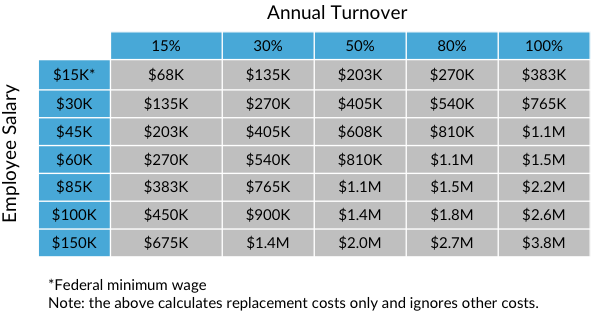
The biggest challenge when it comes to turnover is identifying the root cause(s) of the problem. Companies spend hundreds of thousands of dollars monitoring employee engagement, adding expensive company perks, training managers, etc., all under the assumption that such efforts will help reduce their turnover. The reality is that although these methods each have merit, they are, in fact, not the main driver behind high turnover.
Want to calculate the cost of employee turnover at your company?
Click here to download our "Cost of Turnover Calculator"
2. Employee Engagement: Not the Answer to Turnover We Hoped For
One of the most common strategies for reducing turnover has been to invest in employee engagement initiatives. These efforts take many forms (engagement surveys, manager trainings, expensive company perks, etc.).
It is true that the more engaged an employee is the less likely they are to turnover. However, disengagement is only one of many factors that lead to turnover – and as will be shown in section 5 of this guide, it’s not as significant a driver as many think.
What’s more important, efforts to reduce turnover by improving employee engagement have not had the impact many hoped they would. According to Bersin & Associates, U.S. investment in employee engagement initiatives grew from $750M / year in 2012 to $1.5B / year in 2017. Unfortunately, despite a 108% increase in investment, employee engagement levels have remained relatively flat over that same period.
Illustration B:
U.S. employee engagement levels (2011-2017)
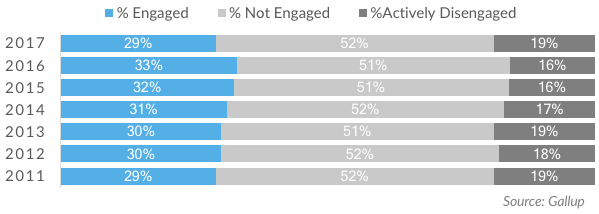
Why has such a massive investment yielded so little?
Certainly it’s not because employees aren’t trying. A recent study by the Conference Board found that 96% of employees actively strive to maintain a high level of engagement, despite struggling to do so (HBR 2018).
One possibility is that engagement has more to do with the internal motivators that drive a person rather than external influences put forth by the company. Indeed, many hiring managers have observed employees who seem to have brought their engagement with them to the job from day 1.
It’s very common to observe two workers in the same position and work environment who demonstrate very different levels of engagement. Externally, their situations are identical, but internally they have very different traits and past experiences that drive them.
This certainly is supported by a recent meta study, which aggregated data from 114 independent employee surveys. The results of this study found that a whopping 50% of the variability in employee engagement was explained by a person’s personality (HBR 2018).
If there is anything you should takeaway from the above examples, it’s the following:
- First, nationwide efforts to reduce turnover through improved employee engagement have yielded little results.
- Second, research suggests that an employee’s level of engagement in a job is more likely the result of his / her own personal traits than any engagement initiatives undertaken by the company.
- Third, if the above is true, then the best way to increase employee engagement is to focus on hiring people more likely to be engaged.
- Fourth, if true for employee engagement, the same holds true for turnover. As will be shown in the next section, the best way to reduce turnover is not to increase your investment in post-hire initiatives, but rather improve your hiring process in such a way that you are more effectively screening out those most likely to turnover.
3. Reducing Turnover Starts With Hiring
Jim Collins said that “the most important decisions business people make are not what decisions, but who decisions.” If 80% of your turnover is the result of bad hiring decisions, the most important thing you can due to reduce turnover is to focus on hiring people more likely to stay.
To be clear, this isn’t to say that people aren’t influenced by their work environments. Indeed, they are. However, the training and experiences an employee has had before coming to your company will vastly outweigh whatever experiences they have during the limited time they spend at your company.
Illustration C: 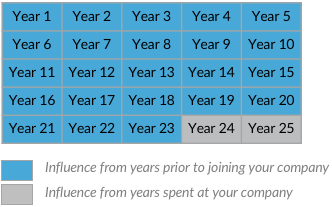
By the time a 24 year-old is hired at your company, the influence from pre-hire years will outweigh the influence of whatever time you spend with him/her by a factor of ~23 to 2 - and that’s being generous.
That’s a 1050% larger impact.
Any efforts a company may take post-hire to influence an employee will pale in comparison to the influence of their past life experiences as well as their own personal traits.
Given this fact, it’s surprising that only the most innovative companies have grasped the power of screening for turnover risk. Far too many companies focus solely on screening for the traditional factors (performance-related criteria, culture, etc.) when in reality, screening for turnover is the answer they have been waiting for.
4. How Much of Your Screening Process Should Focus On Turnover?
Once you have decided to begin screening for turnover in your hiring process, the next question is how much of the process should focus on turnover?
Certainly, we are not advocating for 100%. There are many other important factors to evaluate in a candidate (performance-related, culture-related, and so on).
The portion of your screening process dedicated to screening for turnover risk vs. cultural fit and performance will (and should) vary depending on the company and position.
The following questions can serve as a helpful guide for positions at your company:
- How high is your turnover?
- How difficult is the job?
- How much interaction with others will the job require?
The higher the turnover (#1), the greater the percentage of your hiring process that should be allocated towards screening for turnover risk.
Likewise, the less challenging the job (#2), the more you can afford to replace steps in the screening process traditionally reserved for more performance-related criteria.
This may seem obvious but it’s often not. As one anecdotal example, we recently began working with a retail client who’d been using sophisticated intelligence-based assessments to hire for a cashier position. In isolation, this wasn’t a bad thing. Every job requires some minimal threshold of intelligence and mental ability is one of the best known predictors of performance (generally speaking) that we have. However, an audit of this company’s screening process revealed that they were almost entirely focused on performance-related criteria with almost nothing related to turnover. This might be fine for some positions, but for a cashier position with >100% annual turnover it was a mistake.
|
A good gauge for this is to ask yourself the following the question – assuming they were given the basic amounts of initial training required, what percentage of the population selected at random could do the job you’re hiring for? If the answer is 5% or 1%, most of your hiring process should screen for performance-related criteria. If the answer is 50% or 75%, you not only can afford to make turnover a larger focus in screening, you should. |
The last question to ask is how much interaction with others will the job require (#3). The less interaction that is required, the more you can afford to also substitute effort traditionally reserved for the cultural fit screen for a turnover (or performance) screen instead.
|
A good rule of thumb here is the jerk test. How many people would be affected if I hired a jerk for this position. If the answer is a lot (as would be the case for example in a management or customer-facing position), then cultural fit should occupy a large portion of your screening process. If a jerk in the position wouldn’t impact that many people, then you can afford a bit more focus on turnover or performance. |
To be clear, this test is to determine how to allocate the limited time you have in your screening process. We are certainly not advocating that you hire jerks. : )
Illustration D: Screening Process by Outcome Focus Area
Customizing your screening plan based on the realities of the job helps ensure you’re focusing on the outcomes that matter most for each position.
Example Position 1:

Example Position 2:

Screening for turnover is the step that companies most often overlook.
5. Eleven Traits That Make a Candidate More Likely to Stay
Once you’ve decided what portion of your screening process should focus on turnover, the next question is what should you screen for?
Below are the results from one of the largest turnover meta studies done, which aggregated insights across hundreds of independent studies.
Illustration E:
Turnover Predictors Based on Meta Study from Rubenstein et al 2018.
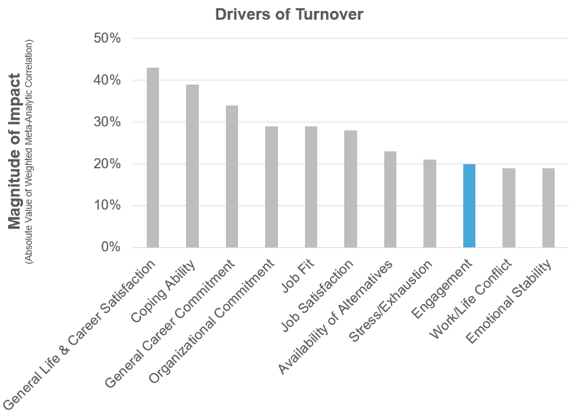
There are a few insights related to the meta study that should be noted:
- First, you’ll notice employee engagement is on the far right. As mentioned previously, there are many factors that influence turnover more than employee engagement.
- Second, you’ll notice that the majority of the turnover predictors listed are related to the person, or at least, person-job fit, not the job itself. In other words, these are things that can be screened for before a hiring decision is made.
The ability to screen candidates for the above criteria can have a large impact in your efforts to reduce turnover at your company. Of course, every company and position is unique so you’ll want to customize your approach, but the above criteria can be a great place to start.
|
The most important takeaway of the turnover meta study Most of the turnover predictors can be screened for before hiring. |
6. Eight Example Interview Questions Guaranteed to Flag Flight Risks
Once you have a good idea of the kinds of things to screen for, the next step is to begin crafting effective ways to screen for those traits. Below are a few examples of interview questions you might consider adding to your process. All the attributes suggested below have been shown via decades of research to be highly predictive of retention.
General Life & Career Satisfaction:
The degree to which an individual likes other aspects relevant to employment, such as his or her career career or life in general.
|
Example A Interview Question: On a scale of 1-10, how satisfied would you say you are with your career right now, and why? |
Example A Explanation:
They key to this question is to gauge the overall level of positivity or negativity of the candidate. Research has shown an overall positive perspective on life and one’s career translates directly into higher retention on the job as well.
|
Example B Interview Question: Tell me about the worst situation you got yourself into at your last employer? |
Example B Explanation:
Viewed through a turnover lens, this question is much more about how the candidate views the event than how they got there in the first place. You’re watching for whether the candidate views those situations from the perspective of an optimist or a pessimist. Pessimists are more likely to be dissatisfied in a general sense with life and their careers - and research has shown this translates directly into a higher likelihood of turnover as well.
Coping Ability:
An individual’s abilities to manage internal and external demands that are perceived as exceeding available resources.
|
Example A Interview Question: Tell me about a time you experienced burn-out. What caused it? How did you handle it? |
Example A Explanation:
You’re essentially looking for evidence that this person can juggle multiple hard things. The more difficult the demands placed upon them (both internal and external to a job) and the greater the evidence that they were able to manage those demands, the greater the evidence that they can do the same at your organization. If helpful, how the candidate responded to that trying time can be confirmed via a reference call as a well.
General Career Commitment:
The degree to which an individual experiences loyalty to targets other than the organization, such as his or her occupation or career.
|
Example A Interview Question: What are the largest sacrifices you have made thus far for your career? |
Example A Explanation:
The past is the best predictor for the future, and a person who can demonstrate above average commitment to the success of his/her career is more likely to bring that same commitment to you at your organization. Research has shown this trait to be highly correlated with retention.
|
Example B Interview Question: On a scale of 1-10, how important would you say your career is to you? How has that impacted your decisions thus far? |
Example B Explanation:
To be clear, this is not an exercise to make sure people value their career success above all else. The best candidates often have many values they hold dear, many which are held in higher esteem that career success. However, you are looking for strong evidence of commitment to one’s career in the form of diligence, perseverance, or sacrifice.
Job Fit:
Compatibility between an individual and a work environment that occurs when their characteristics are well matched.
|
Example A Interview Question: Can you tell me the [3] main reasons you have left jobs in the past? |
Example A Explanation:
You’re looking for themes for their leaving prior jobs that are likely to apply to the current job environment as well. For example, if a person has left a job in the past due to a lack of opportunity, follow-up questioning may reveal whether they’ll encounter those same kinds of issues in the role they’d be assuming at your company.
|
Example B Interview Question: What are your strengths? |
Example B Explanation:
This can be a very common interview question; however, viewed through a turnover lens gives a candidate’s response a slightly different interpretation. According to research, people who use their strengths at work every day are 6x more likely to be engaged (Gallup). Knowing how a candidate’s strengths match those things they’ll be doing daily in the job can be a good early indicator of the degree to which they’ll feel suited for the role. People are more likely to stay in jobs where they can become their best selves and it’s hard to be your best when you’re using your left hand and you’re right handed.
Organizational Commitment:
The degree to which an individual experiences loyalty to the organization and desires to stay. Includes all three facets of organizational commitment: affective (a desire to stay), normative (an obligation to stay), and continuance (a need to stay) commitment (Meyer & Allen, 1991).
|
Example A Interview Question: Why did you apply to this position? |
Example A Explanation:
You’re looking for as much candidate alignment with the organization and what it does as possible. This could come in the form of an affinity for the company’s product, a passion for its mission, or a host of other potential attractions. All can serve as evidence to some degree that the person is more likely to stay once hired.
The above are just a few examples, but hopefully they go to show that viewing candidate evaluation process through the lens of retention-related criteria can transform the way you interpret the candidate’s response.
Please contact us at contact@journeyfront.com if you’d like to discover other research-backed examples in addition to what’s above.
7. Track Your Results For Continuous Improvement
Once you’ve successfully implemented a turnover screen into your hiring process, you’ve taken a major step in the right direction, but you’re not done yet.
The last and perhaps most important step is to measure your progress against turnover on a per hire basis – specifically compared to the new hire attributes you’ve screened for. This involves tracking how hires were scored in the screening process against their tenure at the company.
Because every company and position is different, in order to identify what is working for you, results need to tracked at this level so you can continuously validate and refine your approach.
Over time, the effectiveness of your screening process will improve (as will your turnover). You’ll be able to identify which attributes matter most for your company, which screening methods best identify those attributes, etc. The good news is the higher your turnover, the shorter your feedback loop (i.e., the quicker you’re able to learn what aspects of your turnover screen are working). If you’ve keeping track of your data in the right way, you’ll easily be able to go back and identify any hires that turned over in the first few months to determine what worked as well as generate new ideas for how to improve.
If needed, various technologies can do the heavy lifting for you in this effort, including Journeyfront’s solution.
|
The most important step is to measure your progress against turnover on a per hire basis – specifically in relation to the attributes you’ve screened for. |
8. Conclusion
When it’s all said and done, the priority is to hire the best candidate possible for the job. Determining what that entails is the hard part, given it varies widely from job to job and company to company.
For companies with high turnover, the most important thing to take away from this guide is that your screening plan for identifying great candidates has to include retention-related criteria. You can hire the most superb performer on the planet, but if he/she leaves your company after only 1 month, he/she wasn’t a successful hire.
The second most important thing to take away is that when it comes to reducing turnover in hiring, data is your greatest ally. Reducing turnover in hiring will require being deliberate about what you’re screening for and why you’re screening for it – and being willing to collect data as you go so that you can continuously improve over time.
This might seem like a lot of work but the cost of turnover is so great that the effort is far worth it. Companies have saved millions of dollars employing the strategies explored in this guide. We wish you the same success.
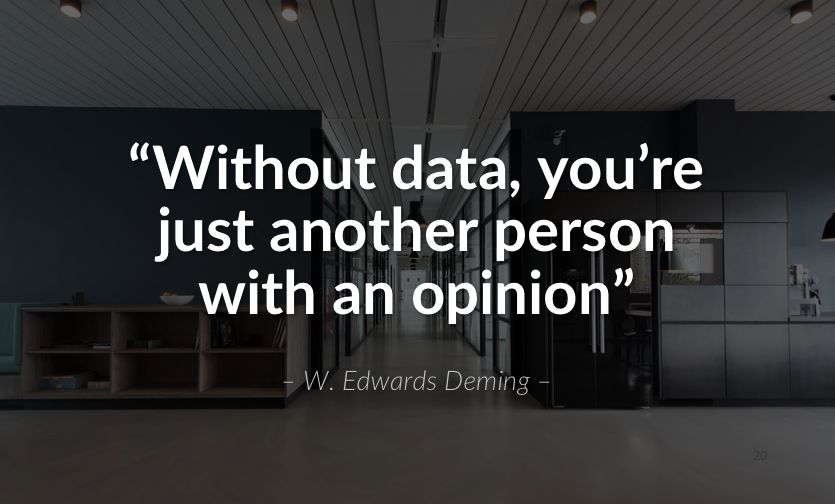
Was this guide helpful? Click here to download the guide for later. 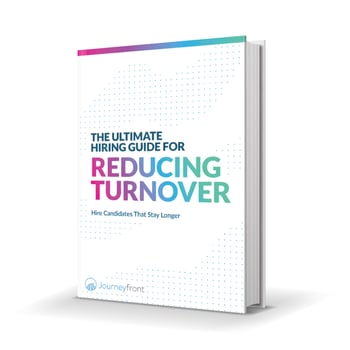
|



